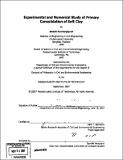Experimental and numerical study of primary consolidation of soft clay
Author(s)
Korchaiyapruk, Attasit, 1977-
DownloadFull printable version (127.4Mb)
Other Contributors
Massachusetts Institute of Technology. Dept. of Civil and Environmental Engineering.
Advisor
John T. Germaine.
Terms of use
Metadata
Show full item recordAbstract
This research investigates, experimentally and numerically, the three main factors that differentiate predictions based on Terzaghi's one-dimensional consolidation theory from those observed in the laboratory and field. These factors include 1) the non-uniqueness of the virgin compression line when the same soil specimen is subjected to different strain rates, 2) the effects of hydraulic gradient on consolidation behavior, and 3) the scaling effects based on ... from oedometer tests with varying drainage heights. This research is separated into two main parts including the experimental program and the numerical simulation program. The experimental program is set up to test the strain rate sensitivity, effects of hydraulic gradient on the consolidation behavior based on the Gradient-controlled Constant Rate of Strain (GCRS) tests, and the scaling effects on the oedometer tests. The tests are performed on two natural soils, Maine Blue clay (MBC) and San Francisco Bay mud (SBM). The numerical simulation programs focus on the simulation of the GCRS test to simulate the excess pore pressure distribution during the gradient-controlled loading phase and the oedometer tests. The strain rate sensitivity tests show that while the MBC behavior is essentially strain rate independent for strain rate faster than 1.5 %/hr, the SBM clearly shows strain rate dependent behavior. The GCRS test results together with the predicted average excess pore pressure from the simulation indicate that while high gradients shifts the Virgin Compression Line (VCL) to the left of the normal VCL for both soils, SBM shows more pronounced effects than MBC. The results from a series of oedometer tests with varying drainage heights also show that the cv ratio based on the MBC tests is independent of the drainage heights. The SBM tests, on the other hand, clearly show that the cv ratio is dependent on the drainage heights. The representative cv can also be predicted from the oedometer simulation. A relationship between ... and the drainage height obtained from the simulation can be used to obtain cv(rep) based on the ... from an oedometer test for engineering applications.
Description
Thesis (Ph. D.)--Massachusetts Institute of Technology, Dept. of Civil and Environmental Engineering, 2007. Includes bibliographical references (p. 169-171).
Date issued
2007Department
Massachusetts Institute of Technology. Department of Civil and Environmental EngineeringPublisher
Massachusetts Institute of Technology
Keywords
Civil and Environmental Engineering.